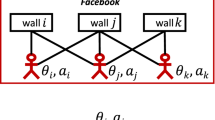Abstract
The internal feedback structure exists in non-hierarchical complex networks in the form of cycles. Diffusion of information from a node to reach out all the rest occurs through penetration layers (depths). The information credibility or accuracy may be challenged in each layer due to internal feedback loops. In this work, we study feedback diffusion capacity and analyze existing patterns of relationships and ties among complex networks entities to find how the feedback of information is diffused and propagated through the network. As the information propagates to subsequent layers, on average, the feedback density heterogeneity in complex networks reaches saturation after the third penetration in random and scale-free networks. The maximum penetration defines the feedback capacity of the network. The experiment results show that in the third and in most networks the fifth penetration depth covers almost 90 % of the nodes. In the small-world networks, the feedback capacity is dynamic and continue increasing as the network size increases. Small-world network has the best feedback capacity among networks configuration. A case study on real Facebook network shows a feedback capacity that resembles random networks.



















Similar content being viewed by others
References
Albert R, Barabási AL (2002) Statistical mechanics of complex networks. Rev Mod Phys 74(1):47–97
Chua V, Madej J, Wellman B (2011) “Personal communities: the world according to me”, In: Jhon Scott, Peter J (eds) The SAGE Handbook of Social Network Analysis, Carrington, ISBN: 978-1-84787-395-8, pp 101–115
Costa LdF, Rodrigues FA (2006) Characterization of complex networks: a survey of measurements. Instituto de Física de São Carlos, Universidade de São Paulo, Brazil
Cyganiak K (2012) “Visualizing How facebook has changed social interaction worldwide”, internet and social media. Retrieved From (http://www.cygy.com)
Costa L. da F, Rodrigues FA, Travieso G, Villas Boas PR (2007) “Characterization of complex networks: a survey of measurements”, advances in physics, In: Advances in Physics, 56 (1)
de Nooy W, Mrvar A, Batagelj V (2005) Exploratory social network analysis with Pajek. Cambridge University Press, New York
Gjoka M, Kurant M, Butts CT, Markopoulou A (2010) “Walking in facebook: a case study of unbiased sampling of OSNs”, Proceedings of IEEE INFOCOM ‘10. San Diego, CA
Hofstad R (2012) “Random graphs and complex networks”, Eindhoven University of Technology, Department of Mathematics and Computer Science
Huber G (1982) Organizational information systems determinant of theory performance and behavior. Man Sci 28(2):138–155
Iribarren JL, Moro E (2007) Information diffusion epidemics in social networks. Phys Rev Lett 103:12
Jamali M, Ester M (2010) “Modeling and comparing the influence of neighbors on the behavior of users in social and similarity networks”, IEEE International Conference on Data Mining Workshops
Jeragh M, Al-Shiridah G, Hrishiah M, Zayoud M (2012) “Improve market response by measuring group influence in social networks”, IADIS International Conference. Web Based Communities and Social Media 2012 (WBC 2012), Lisbon, Portugal
Keller S (1968) The urban neighborhood. Random House, New York
Koelman J (2012) “What is entropy”, Retrieved from (http://www.science20.com)
Li J, Wang BH et al (2008) Network entropy based on topology configuration and its computation to random networks. Chin Phys Lett 25(11):4177–4180
López-Pintado D (2004) Diffusion in complex social networks, PhD thesis. University of Alicante, Spain
Mahdi K, Farahat H, Safar M (2008a) Temporal evolution of social networks in Paltalk. In: Proceedings of the 10th International Conference on Information Integration and Web-based Applications and Services (iiWAS)
Mahdi K, Safar M, Sorkhoh I (2008b) Entropy of robust social networks. IADIS International Conference e-Society, Algarve
Mahdi K, Safar M et al (2009a) Cycle-based versus degree-based classification of social networks. J Dig Info Man 7(1):383–389
Mahdi K, Safar M et al (2009b) A model of diffusion parameter characterizing social networks. IADIS International Journal on WWW/Internet 7(1):136–151
Marinari E, Semerjian G (2006) “On the number of circuits in random graphs”, J Stat Mech Theory Exp
Rios PDL, Lise S, Pelizzola A (2001) Bethe approximation for self-interacting lattice trees. EPL (Europhy Lett) 53(2):176–182
Safar M, Mahdi K, Al-Shiridah G (2012a) “Feedback capacity of random networks”, In: The 15th International Conference on Network-Based Information Systems (NBiS-2012), Melbourne, Australia, pp 26–28
Safar M, Mahdi K, Jammal L (2012b) Cyclic entropy of collaborative complex networks. IET Communications 6(12):1611–1617
Scott J (2000) Social network analysis: a handbook. Sage Publication Ltd., London
Sole R, Valverde S (2004) Information theory of complex networks: on evolution and architectural constrains. Lect Notes Phys 650:189–207
Sorkhoh I, Mahdi K, Safar M (2010) “Computation non-intensive estimation algorithm for counting cycles in random networks”, in real-time and stream applications, iiWAS2010. France, Paris
Strang D, Soule SA (1998) Diffusion in organizations and social movements: from hybrid corn to poison pills. Ann Rev Sociol 24(1):265–290
Valente TW (2005) Networks models and methods for studying the diffusion of innovation. Structural Analysis in the Social Sciences 28:96–116
Watts DJ, Strogatz SH (1998) Collective dynamics of small world networks. Nature 393(6684):440–442
Wellman B (1979) The community question. Am J Sociol 84:1201–1231
Young HP (2003) The diffusion of innovations in social networks. In: Blume LE, Durlauf SN (eds) The economy as an evolving complex system III. Oxford University Press, Oxford
Young HP (2007) Innovation diffusion in heterogeneous populations: contagion, social influence, and social learning. Department of Economics, University of Oxford, UK Discussion Paper Series, No. 303
Acknowledgments
The authors like to acknowledge and thank the Graduate School at Kuwait University for their financial support. Without their devoted help, we could not have managed to finish the project.
Author information
Authors and Affiliations
Corresponding author
Rights and permissions
About this article
Cite this article
Al-Shiridah, G., Mahdi, K. & Safar, M. Facebook feedback capacity modeling. Soc. Netw. Anal. Min. 3, 1417–1431 (2013). https://doi.org/10.1007/s13278-013-0137-5
Received:
Revised:
Accepted:
Published:
Issue Date:
DOI: https://doi.org/10.1007/s13278-013-0137-5




